 |
 |
Daniel Chester French was commissioned to make several memorials to those who gave their lives during "The Great War" (which, after 1940, came to be known as "World War I"). One of French's most beautiful and poignant war memorials is the one commissioned by St. Paul's School in Concord, New Hampshire.
In the winter of 1922, the alumni magazine of St. Paul's School, Alumni Horae, announced that a joint Committee of Trustees and Alumni discussed, at their meeting of December 9, 1921, the commissioning of an appropriate memorial in honor of the forty-eight St. Paul's School students who died during the war. The announcement read, in part:
The main cleavage is between utility and beauty. Shall the memorial be a building, the primary purpose of which is use; or shall it be an object, the main purpose of which is beauty? Until this important problem is settled the committee cannot go forward.
By Spring of 1924, the problem had been settled, and the committee had accepted a design for a memorial sculpture by Daniel Chester French. An impressive brochure (undated) was produced by St. Paul's School to aid in raising the $50,000 required for French's sculpture and its setting in the School's Chapel of St. Peter and St. Paul. The setting was designed by J. Gamble Rogers. A photograph of a plaster model of French's design was included in the brochure.
The brochure included a lengthy quotation from Daniel Chester French regarding his design - an Angel holding a dying young soldier - which are similar to his words he used to describe his design for the Milmore Memorial ("The Angel of Death and the Sculptor"). The brochure reads:
When asked by the Committee as to the spiritual significance of the sculptured group, Mr. French wrote in part:I think it was Emerson who said that "a poet is entitled to credit for anything that anyone can find in his poetry," and surely it is often that an artist puts into his work something that he feels but has never expressed in words. As a matter of fact, I have never been able to give a name to the winged figure that supports the dying youth. I have called it the Angel of Death, but it has been the custom in Christian art to represent death with all the terror of skull and cross-bones, which is not what I wish to have recalled and which has never seemed to me a Christian spirit. It has remained for a pagan Greek to give what seems to me more in the Christian spirit - "That men may be content to live, the gods have hidden from them that it is sweet to die." It is this that I should like to have my group convey; - that the angel who is taking the youth in her protecting arms is ushering him into a higher and better life.
French's magnificent sculpture is in a dramatic setting in a small ante-chapel on the north wall just to the left of the main interior (west) entrance of the Chapel of St. Peter and St. Paul at St. Paul's School. Dedicated on January 26, 1929, the sculpture is in an alcove on which appear the names of the forty-eight St. Paul's School students who died during the war. The inscription on the bass of the Memorial reads:
The St. Paul's School War Memorial ("Death and Youth") is located in the Chapel of St. Peter and St. Paul on the campus of St. Paul's School, Concord, New Hampshire.
Apart from those credited to St. Paul's School and the public domain image of Michelangelo's "Pieta," all photos below were taken by Douglas Yeo in August 2009 (photos of The St. Paul's School War Memorial") and October 2001 (photo of French's "Angel of Death and the Sculptor").
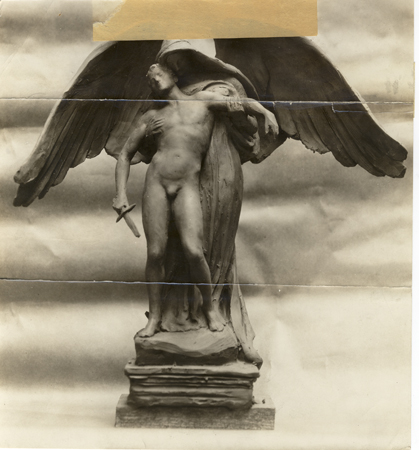
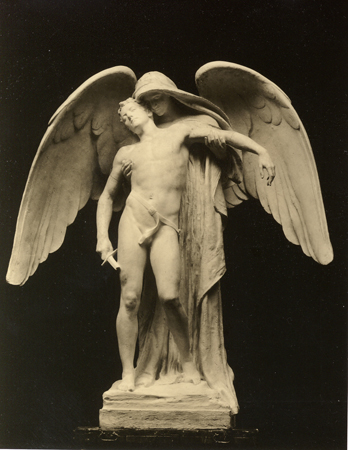
|
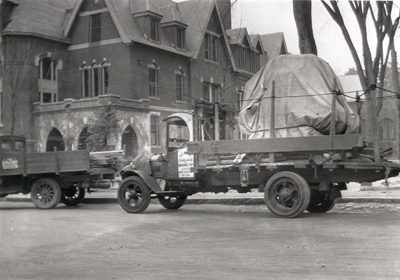 This photograph, courtesy of the St. Paul's School archives, shows the War Memorial being delivered to the school in late 1928. The War Memorial was carved
by the Piccirilli Brothers of New York City who carved all of French's marble monuments from his clay or plaster models.
This photograph, courtesy of the St. Paul's School archives, shows the War Memorial being delivered to the school in late 1928. The War Memorial was carved
by the Piccirilli Brothers of New York City who carved all of French's marble monuments from his clay or plaster models. |
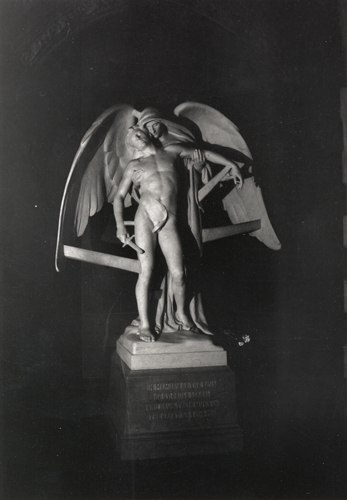 This dramatic and historically important photograph, courtesy of the St. Paul's School archives, shows the War Memorial sculpture in place in the Chapel of St. Peter
and St. Paul. The sculpture still has the marble braces in place which helped provide stability to the group during transport to the School. These braces were
later removed by the Piccirilli Brothers.
This dramatic and historically important photograph, courtesy of the St. Paul's School archives, shows the War Memorial sculpture in place in the Chapel of St. Peter
and St. Paul. The sculpture still has the marble braces in place which helped provide stability to the group during transport to the School. These braces were
later removed by the Piccirilli Brothers. |
The brochure produced by St. Paul's School to assist in raising funds for the War Memorial contains stirring words from Owen Wister, the American author who studied at St. Paul's School and wrote many novels about the American West, including, "The Virginian." His words, below, are striking in how they could have easily been penned today, nearly 100 years after the beginning of "The Great War":
What is a school such as St. Paul's, what are all schools like it, since a Democracy must depend upon the virtue of all its people? Does not this virtue itself depend upon the teaching of sound doctrine? Seventy years such a teacher, is not St. Paul's among the cornerstones of our Temple?Think over our blunders in foreign and domestic policy. Do they come from bad qualities of national character? Not at all. They are the result of undisciplined emotion and untrained reflection. In no country can training ever mould all the people until training keeps pace with the birth-rate; but enough of it can be spread among us to season some of the crudities which sway our legislation decade after decade, and to spare us the unhappy consequences of these outbreaks of endemic hysteria.
The voice of the people is more frequently the voice of the madhouse than it is the voice of God. No Ship of State has ever yet been captained by the steerage and escaped the rocks. Ours was headed for the rocks in the Great War. The Great Untrained had to be taught its meaning by the trained.
How does training come? Through games, and halls of brick and mortar, and good books, and good men, and a Light ever burning throughout.
By the Light, even before the hour of obligation, the eyes of St. Paul's boys read that "he that loseth his life for my sake shall find it": and so they led the way and the untrained followed. Not all of these leaders who went came back from the Great War.
Through French's sculptured boy, all his brothers in sacrifice speak to us - sheltered, uplifted, at rest, finding his life thus, he beacons from where the immortals are, lighting the road ahead: a lustrous lamp, burning in the halls of brick and mortar. Let us possess this lamp among our treasures of inspiration.
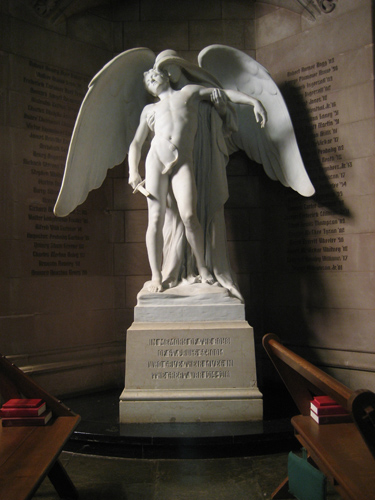 A view of the War memorial from the front, showing the sculpture, base, and setting with names of the forty-eight St. Paul's School students who died during the War
inscribed on the wall. This and all of the following photographs were taken using natural light. Click
HERE
to see a larger, high resolution copy of this photograph.
A view of the War memorial from the front, showing the sculpture, base, and setting with names of the forty-eight St. Paul's School students who died during the War
inscribed on the wall. This and all of the following photographs were taken using natural light. Click
HERE
to see a larger, high resolution copy of this photograph. |
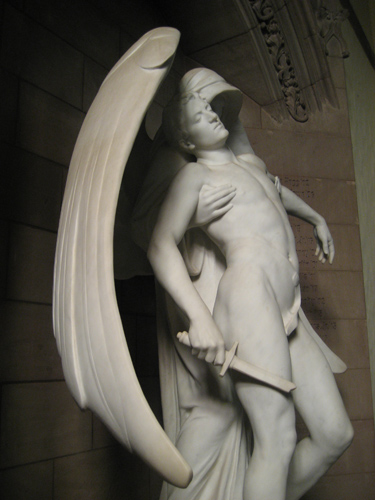 A view of the left side of the War Memorial, showing the Angel's massive, all-enveloping wing.
A view of the left side of the War Memorial, showing the Angel's massive, all-enveloping wing. |
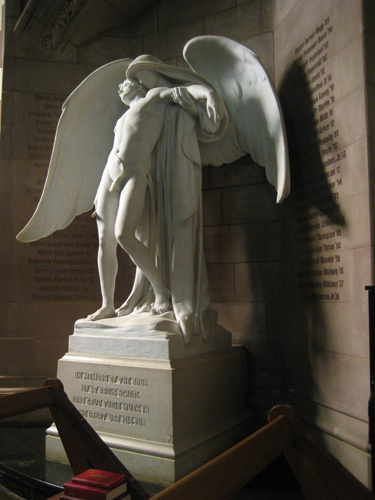 A view of the right side of the War Memorial.
A view of the right side of the War Memorial. |
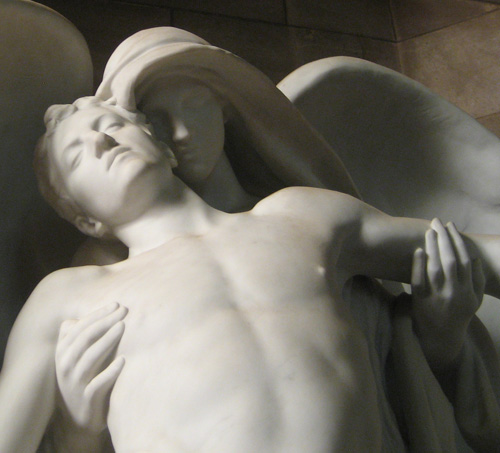
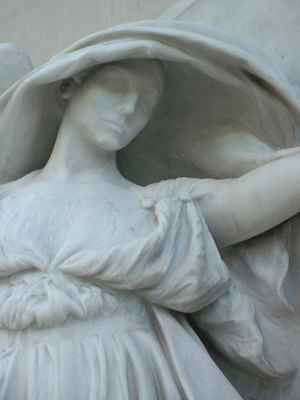 This photograph (left) shows a close up of the faces of the Angel and the Youth. The benevolent expression of the Angel is very similiar to that of the Angel of Death
in French's "Milmore Memorial" (shown at right) which was executed in
in bronze 1889-1893; a
marble copy
for the Metropolitan Museum of Art was completed in 1924.
This photograph (left) shows a close up of the faces of the Angel and the Youth. The benevolent expression of the Angel is very similiar to that of the Angel of Death
in French's "Milmore Memorial" (shown at right) which was executed in
in bronze 1889-1893; a
marble copy
for the Metropolitan Museum of Art was completed in 1924. |
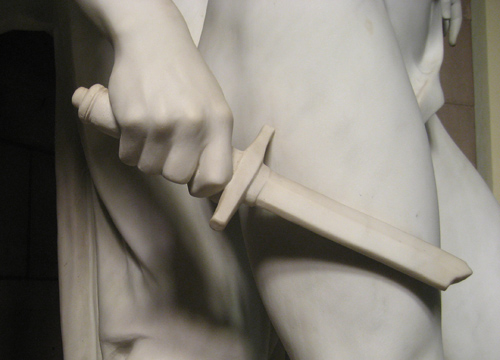 A close up view of the Youth's shattered sword.
A close up view of the Youth's shattered sword. |
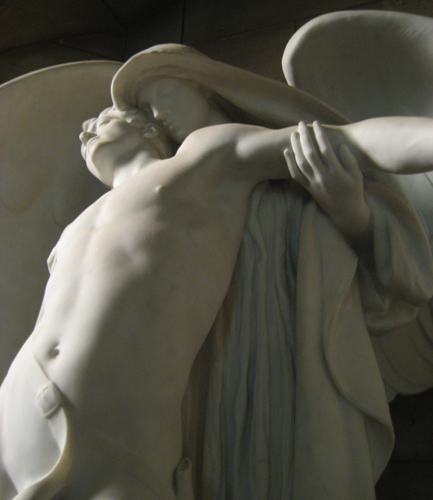
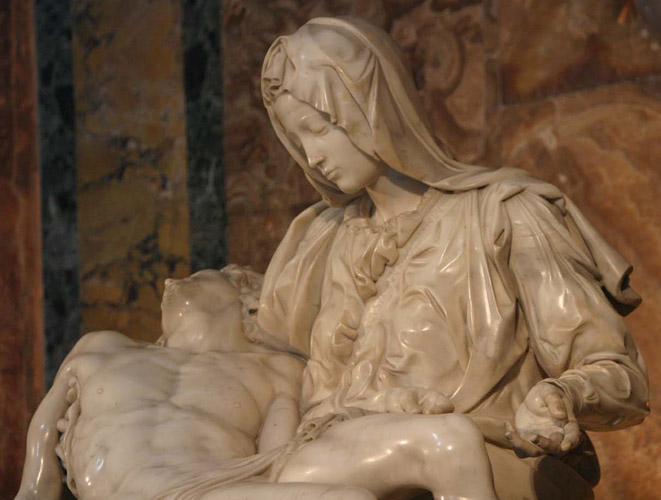 These photographs show the dramatic similarity between French's "Death and Youth" (left) and Michelangelo's "Pieta." |
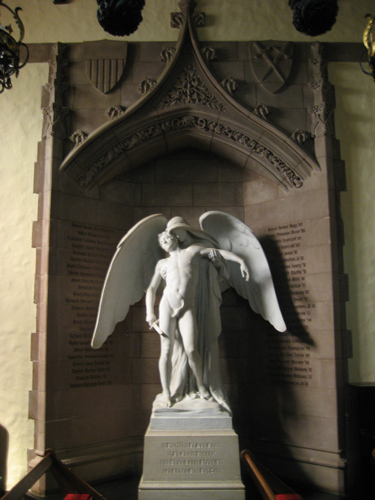 This photograph shows a view of the entire War Memorial alcove.
This photograph shows a view of the entire War Memorial alcove. |
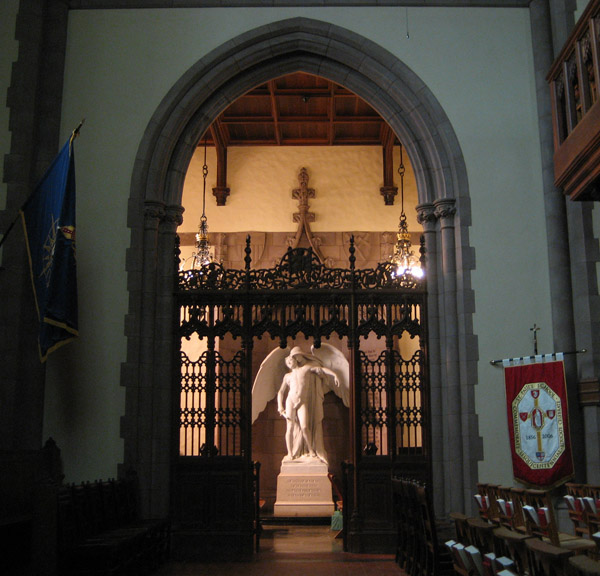 A view from the back of center aisle of the Chapel of St. Peter and St. Paul, looking north, showing Daniel Chester French's "The St. Paul's School War Memorial" ("Death and Youth")
in situ.
A view from the back of center aisle of the Chapel of St. Peter and St. Paul, looking north, showing Daniel Chester French's "The St. Paul's School War Memorial" ("Death and Youth")
in situ. |
The Spring 1929 issue of St. Paul's School's alumni magazine, Alumni Horae, contained an account of the dedication of the War Memorial. It read, in part:
From the chancel Taps was sounded. The Bishop then dedicated the Memorial. After responsive reading of Antiphon and Canticle by the Bishop and the congregation, the hymn, "O Valiant Hearts", was sung. Then, standing by his seat under the gallery and turning towards the Memorial, the Rector delivered the Address. In an attempt to summarize it, its beautiful and moving quality can be but faintly suggested. He spoke of Joshua's command, after the passage of the Jordan, that a monument of stones should be set up, so that subsequent generations should ask, "What mean ye by these stones?" Here on the stones which form the background of our Memorial the names of those whom it commemorates are inscribed. Each name means a child born into the world, a nursery and a mother's love, a boy growing up and going away to school, a boy leaving school, a man going to war, falling, and being raised again. These stones mean love. The men who died fought for no gain to themselves or their country, but in a righteous cause; cheerfully they gave themselves to suffer in cold and filth, to endure wounds, to embrace death. These stones mean sacrifice. And they are a plea for peace, a petition of peace, a pledge of peace. These stones mean peace. It was a deeply moving address; a hushed and reverent congregation listened to it.
|
All rights reserved. |